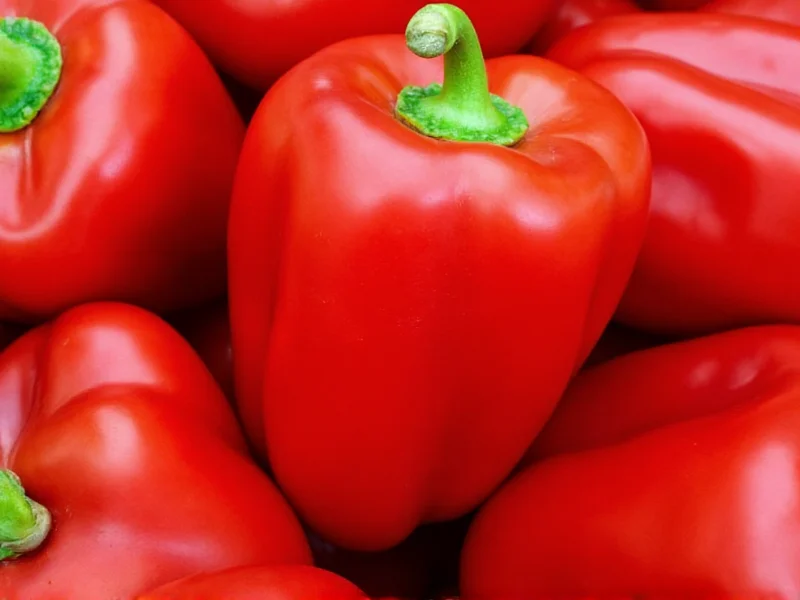Red sweet peppers stand out among vegetables for their impressive nutritional profile relative to their minimal calorie count. These vibrant vegetables consist of approximately 92% water, which explains their low energy density while providing significant volume and fiber to promote satiety. Understanding the complete nutritional picture helps contextualize why red sweet peppers are a staple in weight management and healthy eating plans.
Nutritional Breakdown of Red Sweet Peppers
Beyond their calorie content, red sweet peppers offer remarkable nutritional benefits that make them valuable additions to any diet. As bell peppers ripen from green to red, their nutrient composition changes significantly, resulting in higher concentrations of certain vitamins and antioxidants.
| Nutrient | Per 100g | Medium Pepper (119g) | % Daily Value* |
|---|---|---|---|
| Calories | 31 kcal | 37 kcal | 2% |
| Carbohydrates | 6.2 g | 7.4 g | 2% |
| Dietary Fiber | 2.1 g | 2.5 g | 9% |
| Vitamin C | 128 mg | 152 mg | 169% |
| Vitamin A | 3131 IU | 3726 IU | 124% |
| Vitamin B6 | 0.3 mg | 0.4 mg | 18% |
| Vitamin K | 4.9 mcg | 5.8 mcg | 6% |
| Potassium | 211 mg | 251 mg | 5% |
*Percent Daily Values based on a 2,000 calorie diet
Red vs. Other Colored Bell Peppers: Calorie Comparison
Many people wonder about the differences in calories in red bell pepper versus green. While the calorie differences are minimal, the nutritional profiles vary considerably. Red sweet peppers, being fully ripened, contain significantly higher levels of certain nutrients compared to their less mature counterparts.
A medium green bell pepper contains approximately 24 calories, slightly fewer than the 37 calories in a red pepper of the same size. This small difference primarily reflects the increased sugar content as peppers ripen and change color. The additional calories in red sweet peppers come with substantial nutritional benefits, particularly higher concentrations of beta-carotene, lycopene, and vitamin C.
Health Benefits Beyond Calorie Count
When considering are red bell peppers good for weight loss, the answer is decidedly yes. Their low calorie density combined with high water and fiber content makes them exceptionally satisfying without contributing significantly to daily caloric intake. The fiber content in red sweet peppers (approximately 2.5 grams per medium pepper) supports digestive health and helps maintain stable blood sugar levels.
The impressive vitamin C content—providing more than 150% of the daily recommended value in a single medium pepper—supports immune function and acts as a powerful antioxidant. Additionally, red sweet peppers contain carotenoids like lycopene and beta-carotene, which convert to vitamin A in the body and support eye health and immune function.
Practical Applications in Meal Planning
Understanding how many calories in raw red pepper helps when incorporating them into various dietary patterns. Whether following a Mediterranean diet, low-carb eating plan, or simply aiming to increase vegetable intake, red sweet peppers offer versatility and flavor without caloric penalty.
For those tracking carbs in red sweet pepper, it's worth noting that a medium pepper contains about 7.4 grams of carbohydrates, with 2.5 grams coming from fiber. This makes the net carb count approximately 4.9 grams, which fits well within most dietary frameworks. The natural sweetness of red peppers makes them particularly appealing for those reducing added sugars in their diet.
Chefs and home cooks appreciate red sweet peppers for their ability to add color, texture, and sweetness to dishes. They work well raw in salads, roasted as a side dish, stuffed with grains and proteins, or incorporated into sauces and salsas. Unlike some vegetables that significantly increase in calories when cooked with oils or fats, red sweet peppers maintain their low-calorie advantage even when prepared with minimal healthy fats to enhance nutrient absorption.
Maximizing Nutritional Value
To get the most from your red sweet peppers while maintaining their low-calorie advantage, consider these evidence-based tips:
- Eat them raw when possible to preserve maximum vitamin C content, which can degrade with heat exposure
- If cooking, use minimal oil—just enough to help absorb fat-soluble vitamins like A and K
- Pair with healthy fats like avocado or olive oil to enhance absorption of carotenoids
- Store properly in the refrigerator's crisper drawer to maintain freshness and nutrient density
- Choose deeply colored, firm peppers with smooth skin for optimal nutrient content
When calculating red bell pepper serving size for calories, remember that a standard serving is typically considered one medium pepper (about 119g) or approximately 37 calories. This serving provides substantial nutritional benefits without significantly impacting daily calorie goals, making red sweet peppers an excellent choice for those monitoring their intake.











 浙公网安备
33010002000092号
浙公网安备
33010002000092号 浙B2-20120091-4
浙B2-20120091-4